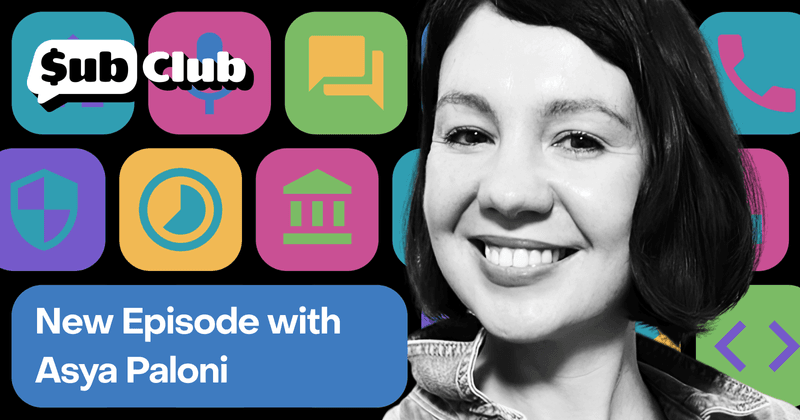“I think that people have the misconception of innovation being spontaneous” — Asya Paloni, Welltory
What to do when there are no jobs to be done, how to build innovative features, and why copying Duolingo’s engagement strategy probably won’t work for your app.

Health and wellness apps have been gaining in popularity for several years. You’ve probably heard of the big names in this space (like Calm and MyFitnessPal), but as users have become more conscious of their health and wellness needs, they’re turning to increasingly niche subscription apps for sleep tracking, fitness, and even sexual wellness.
Welltory is an all-in-one wellness platform that’s focused on giving users highly relevant, engaging, contextualized health and wellness data that truly improves lives. With nearly 9 million active users and a 4.8 rating on the App Store, Welltory proves that providing a useful and delightful app experience is the best way to gain and retain subscribers.
This week on the Sub Club podcast, we chatted with Welltory’s VP of Strategy Asya Paloni to learn how she and her team built a beloved wellness app that retains users in the long run.
Identify your app’s trigger
As a wellness app, one of the biggest challenges Welltory faced is that it doesn’t fit the mold of the traditional “jobs to be done” framework. Apps like Uber and Doordash solve an immediate need for their users (in this case, a ride downtown or a quick meal delivery), but Welltory fulfills a higher-level need: living a healthier life. And that’s a tougher sell in today’s fast-paced world of instant gratification.
To appeal to the mass market, the Welltory team had to identify a broad trigger. “There are no natural triggers that occur in people’s lives that would prompt them to open a health and wellness app,” Asya says. “So we thought the only way that we can make a health and wellness app for the mass market is if we use [boredom as a] trigger and somehow convince people that instead of opening Instagram or TikTok, they can open a health and wellness app — and it would be just as fun and just as entertaining but also good for them.”
Keep users coming back for more
After identifying boredom (or “existential horror,” as Asya calls it) as a trigger for users to open the app, Asya and her team built Welltory to be as novel, entertaining, and rewarding an experience as TikTok or Instagram. “We decided that a wellness app must be extremely entertaining,” she said. “It has to show people something new every time they open the app, and it has to really avoid shaming people… so we embarked on this odd journey of making a wellness app that moves away from the goal setting and the shaming and more towards the TikTok/Instagram type of entertainment.”
To make Welltory as delightful and sticky as possible, Asya and her team follow a 5-step framework:
- Make it magical
- Make it relevant
- Make sense in real time
- Make it novel
- Make it pleasurable
This framework led them to create some of Welltory’s core features, like a visualization of key health metric heart rate variability and social sharing features like a badge for when your fuel tanks are blue.
Don’t try to be Duolingo
Duolingo is one of the biggest success stories in the subscription app industry, but surprisingly, Asya doesn’t invite comparison between Welltory and Duolingo. It’s true that language learning apps and wellness apps have a lot in common (they’re both trying to help users accomplish major life goals), but they fundamentally differ in how they do this. Duolingo nudges users with constant and comically passive-aggressive reminders to open the app and complete a daily lesson. And that works really well for them! But Asya argues that generating feelings of shame is counterproductive for wellness apps. “When people open the app and they haven’t met any of their goals, and their metrics look bad, that’s the last thing you want to see if you’re standing in line and you’re opening an app to distract yourself. You don’t want the existential horror to get worse, right?”
While it might be tempting to copy Duolingo’s strategy, it’s not the right move for every app. If you’re building an app that requires users to put in a lot of time and work outside of the app — not just complete a language lesson in 3-5 minutes — emphasizing feelings of shame probably isn’t the way to go.
Focus on the right features
It’s a tale as old as old as time… prioritizing your backlog of feature requests and ideas is hard. But Asya and her team have learned how to cut through the noise by breaking things down in terms of features types: “musts” and “delighters.” As Asya points out, some features are non-negotiable, either because they prevent user frustration, meet user expectations, match a competitor’s offerings, or fulfill a promise you’ve sold people on. No matter how delightful other features of your app are, to prevent churn, you need to prioritize these “must” features. Once you’ve covered the basics with “must” features, then you can build “delighters:” features that differentiate your app from the competition, help users accomplish jobs delightfully, and provide “aha” or “wow” moments.
You might also like
- Blog post
Gamification in apps: A complete guide to using motivation to drive real value
Daily streaks are not the solution - here are 11 better examples
- Blog post
Apple’s June 2025 EU update: one entitlement, three fees, and CTF’s 2026 sunset
What apps in the EU should do after Apple’s DMA tweak.
- Blog post
7 Meta ad testing frameworks for subscription apps
Balancing speed and accuracy with creative testing

